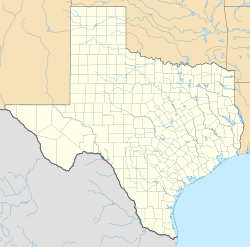El Orcoquisac Archeological District facts for kids
Quick facts for kids |
|
|
Orcoquisac Archeological District
|
|
| Nearest city | Wallisville, Texas |
|---|---|
| Area | 510 acres (210 ha) |
| NRHP reference No. | 71000925 |
| Added to NRHP | July 14, 1971 |
The El Orcoquisac Archeological District is a special historic place in Wallisville, Texas. It is listed on the National Register of Historic Places. This means it is an important site that the United States government wants to protect.
This area is near Galveston Bay. It was once home to Native American tribes like the Akokisa and Bidai. Later, it became an important Spanish fort and trading post.
Contents
What is the Orcoquisac District?
The Orcoquisac Archeological District covers about 510 acres. It holds clues about the past. This includes the remains of an old Spanish fort. It also has signs of where Native American tribes lived.
This site helps us learn about early life in Texas. It shows how different groups interacted. It also teaches us about their daily lives.
Early Days and French Traders
In the early 1700s, French traders came to this area. They were led by a man named Joseph Blancpain. These traders exchanged goods like animal furs and hides with local tribes. They operated near the Trinity River.
The Spanish government claimed this land. They were worried about the French presence. So, they decided to take action.
Spanish Fort and Mission
To protect their claim, the Spanish built a fort in 1756. It was called San Augustín de Ahumada. This fort was built at the El Orcoquisac site.
Inside the fort, they also built a church. This church was a Roman Catholic mission. It was named Nuestra Señora de la Luz. The Spanish hoped to trade and spread their culture.
However, the Spanish trading post was not as successful as the French one. Over time, the fort and mission were moved. They were slowly abandoned in the late 1700s.
Rediscovery and Recognition
For many years, the site was mostly forgotten. Then, in 1965, an amateur historian found it again. His name was John V. Clay.
Because of its historical importance, the site was recognized. It was added to the National Register of Historic Places in 1972. This helps make sure the site is preserved for future generations.



